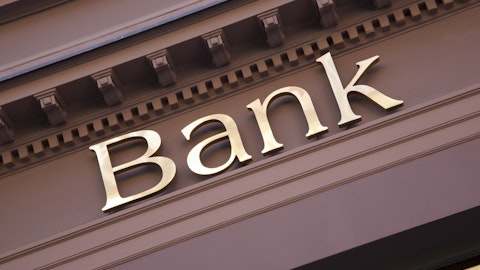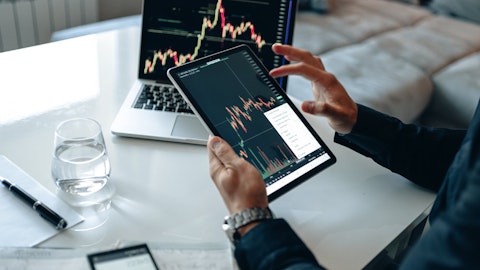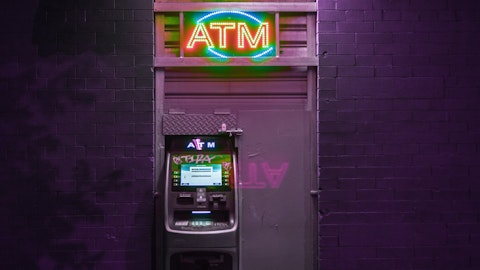Ajai Bambawale: Yes, it’s Ajai. So I’m happy to provide the color. So if you look at our total RWA, it increased CAD26 billion. And you’re right, there’s CAD7 billion of that CAD26 billion is from asset quality and that relates to migration. Some of it is coming from Canadian consumer in resale and in auto, and there’s some coming from U.S. Retail from commercial, auto and cards, and mostly the probability of defaults? What you should also know is that every quarter, when we look at the book and we do a lot of bottom-up analysis, sometimes we force migrate credit to Stage 2. So for example, in Canada, if there’s a client that has reached a trigger point, we would move — even though they’re paying, we would move them to Stage 2 and basically have a higher allowance rate for them.
Similarly, the trigger rate population that we believe that will reach trigger point in the next 12 months will be fairly conservative, move them to Stage 2 and build higher reserves. So some of that is driving the asset quality number of CAD7 billion.
Doug Young: And maybe just, like looking forward, as you kind of look at your PCL expectations in, you know, the evolution of the economic environment, any way to kind of get a sense of what we should be expecting, impact-wise on CET1 ratio from migration? I just see big this quarter, that’s what I’m just trying to understand how to think about this one?
Ajai Bambawale: Well, I am not — I can’t comment specifically on CET1, but you would have seen from my PCL guidance that we expect to see continued normalization of our credit portfolios. The 40 bps to 50 bps range, we’ve given you is a normalized range for TD Bank. So to the extent that that occurs as we expect, then I would expect RWAs also to rise.
Doug Young: Okay. And then in the US Bank, I mean, there was a decent drop in non-interest income. Can you talk a bit about what drove that? Is this kind of a normalized run rate in? And then Kelvin, I think you talked about various one-time items that flowed through expenses. I think these are the items of note that you back out at the top of house in terms of deriving cash EPS, just hoping to make sure that that’s the case?
Kelvin Tran: So, Doug, let me take the first part of that. With regards to the fee income, there were really two factors that played into the drop in the fee income. One is just the drop in value in certain investments, specifically our low-income housing tax credit portfolio. That tends to move around, you know, quite a bit, it’s not as predictable. And so we did see a bit of a write-down in value on that portfolio in the quarter. The second one is a drop in overdraft fees, but specific — it’s related to a remediation effort around a specific type of overdraft fee that’s referred to in the industry as authorized, positive, settle negative. And we took a reserve for client remediation in the quarter. It is a one-time charge. And so as you think about a normalized fee income number for us, I’d encourage you to look back to the second and third quarter of this year as a more indicative run rate fee income number.
Doug Young: Okay. And then those two items, I assume Kelvin, weren’t backed out?
Kelvin Tran: Correct. Those are part of the adjusted earnings. None of them are in item of note.
Doug Young: Not — those two items aren’t backed out. And then the other items that you mentioned Kelvin, like the restructuring charge and other investments that seem to flow through in the U.S., I can confirm this offline, but those are — those are in the cash EPS or backed out?
Kelvin Tran: Those are backed out. So the restructuring charges would be considered item of note and those are backed out of those.
Doug Young: Okay. And then if I could just squeeze one last one in maybe for Riaz, a big increase in capital market expenses adjusted. I think Kelvin talked a bit about some items here, can you maybe just shed some light on what’s going on through the expense line there?
Riaz Ahmed: Yes. Doug, I think, look, no doubt that we’d have to characterize this as a tough quarter for TD Securities for the bottom line, but I think it’s worth unpacking it a little bit for you. I think you’re zeroing on expenses, but I think you should start with the revenue growth story. And if you look at the growth in the global markets and the corporate investment banking revenue, from CAD2.9 billion last year in global markets to CAD3.3 billion this year, CAD1.8 billion in CIB last year to CAD2.8 billion this year. You know, the — we’ve had a 25% lift in our revenue power and to the point that we made at the time of the acquisition of TD Cowen, we’re getting more U.S. M&A revenue, we’re getting more U.S. CCM revenue, we’re getting more U.S. institutional equities revenue.
So our market share rankings in U.S. investment grade bond, in U.S. high yield bonds, in U.S. equity underwriting are all increasing smartly. And in an environment, which is still moderated by market challenges. And we’ve just started optimizing our client coverage and extending our capabilities in the — towards a wider set of verticals and to a wider set of clients. So I think that, you know, when you look at the expenses that have been added this year, you remember that we were growing organically in ’20 and — ’21 and ’22, and then added 1,600 colleagues from TD Cowen and a couple of hundreds of people, who were working on the various integrations. So as we just continue to build out our corporate coverage models, integrate — continue the integration, we announced that we had integrated the equity platform.
So that was a big milestone. You know, our efficiency ratio has risen from 62% last year to 74% this year. And if you look at the quarterly trends in the efficiency ratio, you’ll see that it bounces around. But look, I think that as we integrate over the three-year period that we said we would to get these synergies we were looking for, I think that we will normalize our way to about a 66% efficiency ratio and the potential that we’re building in this franchise and the capabilities we’re adding, I think we will be humming nicely.
Doug Young: Appreciate the color. Thank you.
Operator: Thank you. The next question is from Ebrahim Poonawala from Bank of America. Please go ahead.
Ebrahim Poonawala: Hey, good afternoon. Maybe just going back to Kelvin, comments around the risk and control expenses. So just based on what you said about the Corporate segment, that’s about CAD0.5 billion next year, potentially another CAD0.5 billion in 2025, that continues. Give us the sense of like, when we think about TD, Bharat and — like, you’ve talked about just the consistent management, et cetera. So where did the lapse occur, given just the amount of time and dollars that are required now to remediate that? Any perspective that you can share in terms of why it happened, what actions you’ve taken in terms of changing your approach towards risk management, tech spend on the risk side would be helpful?




